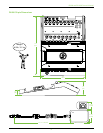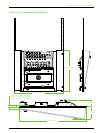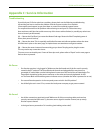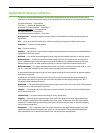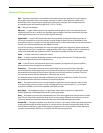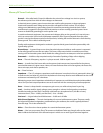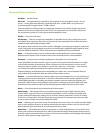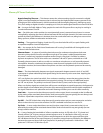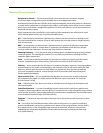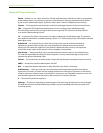
DL806 and DL1608 Owner’s Manual
42
Glossary Of Terms Continued...
Nyquist Sampling Theorem
— This theorem states that, when an analog signal is converted to a digital
signal, it must be sampled at a frequency that is at least twice the highest audio frequency present in the
analog signal. If the audio frequency should exceed one-half the sampling frequency, aliasing may result.
Thus, if an analog-to-digital converter is sampling at 44.1 kHz, the audio signal should not exceed 22.05 kHz.
PA
— Acronym for Public Address. Today, people who work with PA systems like to say they’re working in
“sound reinforcement”. See SR.
Pan
— Pan sliders are used to position (or even dynamically move) a monaural sound source in a stereo
mixing eld by adjusting the source’s volume between the left and right channels. Our brains sense stereo
position by hearing this dierence in loudness when the sound strikes each ear, taking into account time
delay, spectrum, ambient reverberation and other cues.
Peaking
— The opposite of dipping. A peak is an EQ curve that looks like a hill, or a peak. Peaking with
an equalizer amplies a band of frequencies.
PFL
— An acronym for Pre-Fade Listen. Broadcasters call it cueing. Sound folks call it being able to solo
a channel with the fader down.
Phantom Power
— A system of providing electrical power for condenser microphones (and some
electronic pickup devices) from the microphone input jack. The system is called phantom because
the power is carried on a standard microphone audio wiring in a way that is “invisible” to ordinary
dynamic microphones. The DL Series mixers use a standard +48 volt DC power, switchable on or o.
Generally, phantom power is safe to use with non-condenser microphones, as well, especially dynamic
microphones. However, unbalanced microphones, some electronic equipment (such as some wireless
microphone receivers) and some ribbon microphones can short out the phantom power and be severely
damaged.
Phase
— The time relationship between two signals, expressed in degrees around a circle. 0˚ and 360˚
represent an in-phase relationship. Both signals change in the same way at the same time. Anything else
is out of phase.
180˚ out-of-phase is a special case which, for a continuous waveform, means that at any given time the
two signals have the same amplitude but are opposite in polarity. The two legs of a dierential output
are 180˚ out-of-phase. The polarity invert button (found in the EQ view) reverses the signal polarity.
When out-of-phase signals are mixed, there will be some cancellation at certain frequencies, the frequencies
and the degree of cancellation being a function of the amount of phase shift and the relative amplitude of
the signals. Attention to mic placement and careful listening will allow you to use this eect creatively.
Post Fader
— A term used to describe an aux send (or other output) that is connected so that it is aected
by the setting of the associated channel fader. Sends connected this way are typically (but not always) used
for eects. A post-fader output from a mixer channel is usually post-EQ.
Pre DSP
— Pre DSP is ideal when using the auxes for monitor mixes and you want compression and other
eects in the main mix, but not the monitors. Pre DSP is available in all auxes, but not the FX.
Pre Fader
— A term used to describe an aux send (or other output) that is connected so that it is not
aected by the setting of the associated channel fader. Sends connected this way are typically (but not
always) used for monitors.
Q
— A way of stating the bandwidth of a lter or equalizer section. An EQ with a Q of .75 is broad and
smooth, while a Q of 10 gives a narrow, pointed response curve. To calculate the value of Q, you must
know the center frequency of the EQ section and the frequencies at which the upper and lower skirts
fall 3 dB below the level of the center frequency. Q equals the center frequency divided by the dierence
between the upper and lower 3 dB-down frequencies. A peaking EQ centered at 10 kHz whose –3 dB
points are 7.5 kHz and 12.5 kHz has a Q of 2.



